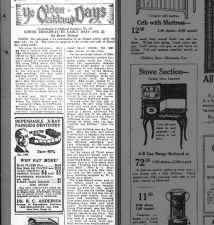.jpg)
Ye Olden Oakland Days
(Contributed by Oakland Pioneers - No. 53)
LOWER BROADWAY IN EARLY DAYS (NO. 2)
By Henry Maloon
(NOTE The following is in continuation of my former article under the same title - No. 52. The writer is supposed to be on the west side of Broadway, going north).
We cross second street. Here we find a cobbler shop owned by Dan Conkwright, a butcher shop owned by Sabe Harris, and on the corner of Third street a grocery store owned by Leonard Johnson. We cross Third street and find Madame St. Germain's grocery store and Dr. Carter's drug store in the one-story brick building (still standing), the first brick building built in Oakland.
Next is Judge Lentell's harness shop. Mrs. Heyman's stoves and tinware, and on the corner of Fourth street Dr. DeTavel has his office and drug store. This is the limit of the business section of Oakland.
A steel tank, 16x16 feet - the town jail - stood on the Plaza where the Court House now is.
Facing the Plaza on Fifth street, between Main (Broadway) and Washington, was a row of one and two-story buildings - Spanish fandango dance houses, the redlight section of the town.
On the northeast corner of Main and Fifth streets was another fandango house, called the "Villa." Here the respectable Spanish residents would gather to enjoy themselves in true Spanish style.
On the site of the Barnum restaurant, southeast corner of Seventh and Broadway, stood the farthest house north on Main street. This house, owned by a man by the name of Taylor, was called the "Rot Gut House," with a sign over the entrance reading, "Rot Gut for Sale." This was the gathering place of the men employed in the mills and lumber camps back of Redwood Peak,
Coming down the east side of Broadway, we now cross Fourth street and stroll back toward the ferry landing. The first house is used as a saloon, afterward Pat Hayes', and next is the office of B. F. Ferris, Justice of the Peace. Adjoining is the law office of George M. Blake, with the sign, "Lawyer and Coroner," over the door.
The next building was the Town Hall. Here the town and school trustees met to transact the town's affairs, and here the police court dealt out justice - or injustice - to the offenders, depending upon their friendship to the court or his backers, for law in those days was flexible.
On the corner of Third Street was the Lambert House, used for a saloon and boarding house. We cross Third street. An old colored woman lives in a little shack with a sign, "Washing and Ironing by Aunt Sally." Next is a small bakery, run by a lady Mrs. Monroe, and on the corner a one-story building occupied by W. T. Myles, as a saloon.
We cross Second street and on the corner stood a two-story structure with an iron veranda across the front at the second story. This was the Golden Eagle Hotel, and next to this was the old Overland stage stables, Pony express and postoffice. Crossing First street stood the Shattuck and Hillegass livery, feed and sales table. To the rear of the stable, facing First street, was the Hotel De France, then one of the most popular resorts in the State. The old building is standing today, now used as a syrup factory.
If those old walls could talk, what stories they would unfold!




